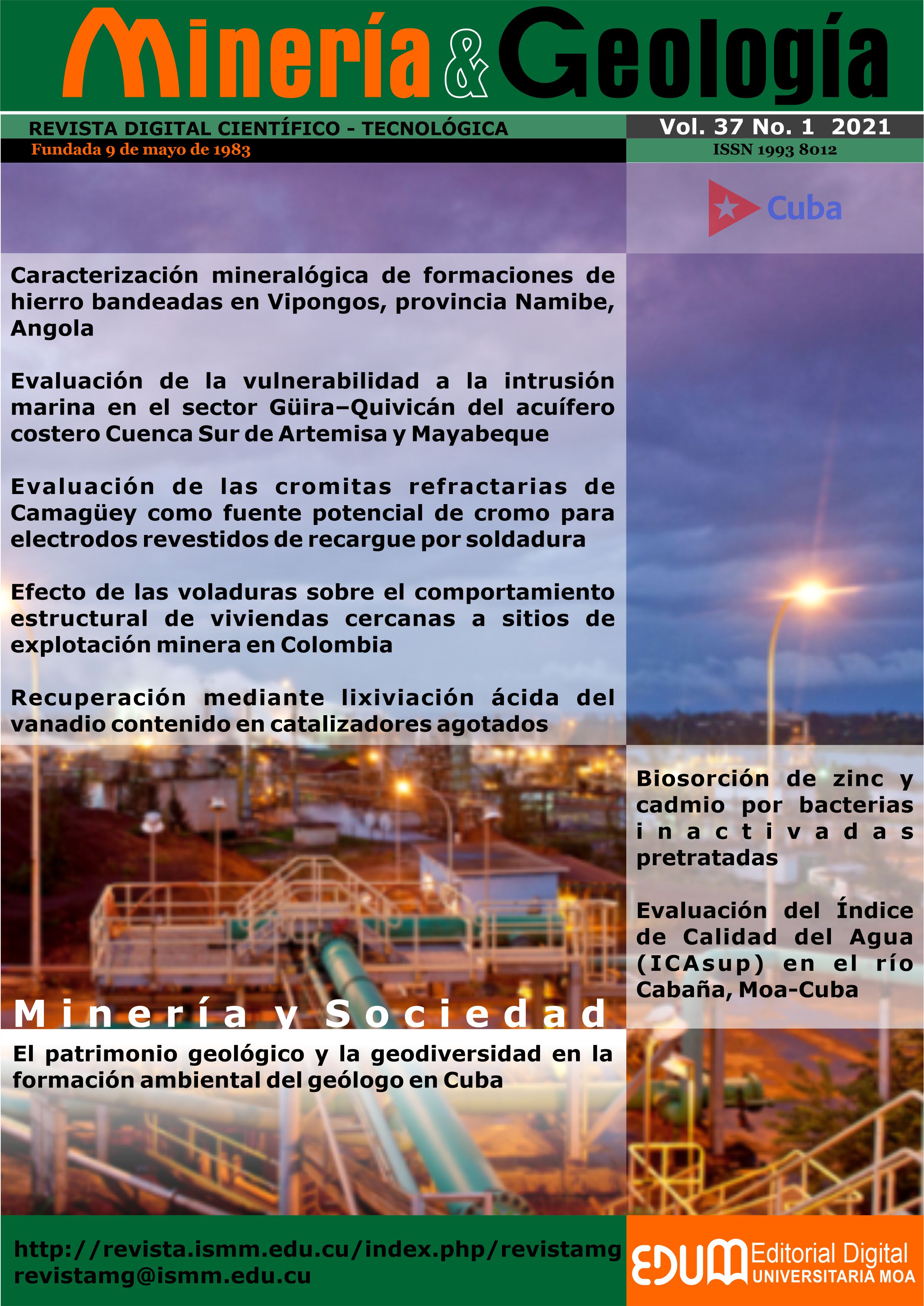Caracterización mineralógica de formaciones de hierro bandeadas en Vipongos, provincia Namibe, Angola
Palabras clave:
formación bandeada, hierro, BIF, chert, magnetita, hematita, esquistos verdes, Vipongos.Resumen
Las formaciones de hierro constituyen uno de los principales recursos minerales de la República de Angola; sin embargo, pocos estudios se refieren a las formaciones ferríferas bandeadas conocidas como BIF (Banded Iron Formation). Este artículo se enfoca en la caracterización mineralógica, mediante técnicas de difractometría y fluorescencia de rayos X, de las formaciones BIF existentes en Vipongos, provincia de Namibe. En el sector central de Vipongos, afloran los cuerpos mayores y mejor desarrollados, compuestos principalmente de cuarzo y hematita, con carbonatos (calcita y dolomita); se asocian a esquistos clorítico–micáceos (clinocloro, muscovita y biotita) estratificados y plegados. Existen, al nordeste, diques de rocas gabro-dioríticas que intruyen secuencias de esquistos verdes. Los rasgos litológicos y geoquímicos de las formaciones BIF en Vipongos permiten asignarlas a un ambiente de formación del tipo Algoma, al estar íntimamente asociadas a esquistos verdes y en ocasiones a rocas volcánicas. Por otra parte, la existencia de elementos menores (V, Co y Sr) y trazas (Ag, In y Ta) atestiguan la ocurrencia de actividad hidrotermal. Estos resultados llevan a pensar que las BIF de Vipongos son una prolongación del Supergrupo Cinturón Móvil Damara, de Sudáfrica.Descargas
Citas
Adekoya, J. A.; Okonkwo, C. T. y Adepoju, M. O. 2012: Geochemistry of Muro Banded Iron-Formation, Central Nigeria. International Journal of Geosciences, 3(5): 1074-1083. doi: 10,4236/ijg,2012,35108.
Anike, O. L.; Umeji, A. C. y Orajaka, I. P. 1993: Geology of Precambrian banded iron-formation from Muro Hill, Nigeria. Economic Geology, 88(5): 1237-1241.
Araújo, A. G. y Guimarães, F. 1992: Geologia de Angola, Notícia explicativa da Carta Geológica à escala 1: 1 000 000. Luanda: Serviço Geológico de Angola.
Bau, M. y Dulski, P. 1996: Distribution of yttrium and rare-earth elements in the Penge and Kuruman iron-formations, Transvaal Supergroup, South Africa. Precambrian Research, 79(1-2): 37-55.
Beukes, N. J. 1973: Precambrian iron-formations of southern Africa. Economic Geology, 68(7): 960-1004.
Beukes, N. J.; De Kock, M. O.; Vorster, C.; Ravhura, L. G.; Frei, D.; Gumsley, A. P. y Harris, C. 2019: The age and country rock provenance of the Molopo Farms Complex: implications for Transvaal Supergroup correlation in southern Africa. South African Journal of Geology, 122(1): 39-56.
Beukes, N. J. y Gutzmer, J. E. N. S. 2008: Origin and paleoenvironmental significance of major iron formations at the Archean-Paleoproterozoic boundary. Reviews in Economic Geology, 15: 5-47.
Bondo, H.F y Carvalho, I. M. 2011: Caracterização geológica e geotécnica da área de implantação do Novo Porto de Luanda. Trabalho de fim De Curso. Universidade Agostinho Neto.
Bontognali, T. R.; Fischer, W. W. y Föllmi, K. B. 2013: Siliciclastic associated banded iron formation from the 3.2 Ga Moodies group, Barberton greenstone belt, South Africa. Precambrian Research, 226: 116-124.
Bronner, G. y Chauvel, J. J. 1979: Precambrian banded iron-formations of the Ijil Group (Kediat Ijil, Reguibat Shield, Mauritania). Economic Geology, 74(1): 77-94.
Caliata, L. A. 2018: Caracterización mineralógica de las formaciones de rocas ferríferas-silicatadas (tipo BIFs) del área de Vipongoss por Difracción de rayos-x. Trabajo de diploma. Universidad de Moa. 42 p.
De Carvallho, H. y Alves, P. 1993: The precambrian of SW Angola and NW Namibia. General remarks. Correlation analysis. In: International Colloquium on Africa Geology. 73-76.
Departamento de Exploración de Gevale. 2013: Mapa geológico do área Vipongos. Convenio Gevale – Universidade Agotinho Neto. Escala 1:25 000. Sistema de Coordenadas GCS-WGS 84 Zona 335. 001/2013.
Derry, L. A. y Jacobsen, S. B. 1990: The chemical evolution of Precambrian seawater: evidence from REEs in banded iron formations. Geochimica et Cosmochimica Acta, 54(11): 2965-2977.
El-Shazly, A. K. y Khalil, K. I. 2014: Banded iron formations of Um Nar, Eastern Desert of Egypt: P–T–X conditions of metamorphism and tectonic implications. Lithos, 196: 356-375.
Fryer, B. J. 1977: Rare earth evidence in iron-formations for changing Precambrian oxidation states. Geochimica et Cosmochimica Acta, 41(3): 361-367.
Frei, R.; Dahl, P. S.; Duke, E. F.; Frei, K. M.; Hansen, T. R.; Frandsson, M. M. y Jensen, L. A. 2008: Trace element and isotopic characterization of Neoarchean and Paleoproterozoic iron formations in the Black Hills (South Dakota, USA): assessment of chemical change during 2.9–1.9 Ga deposition bracketing the 2.4–2.2 Ga first rise of atmospheric oxygen. Precambrian Research, 162(3-4): 441-474.
Fripp, R. E. P. 1976: Stratabound gold deposits in Archean banded iron-formation, Rhodesia. Economic Geology, 71(1): 58-75.
Gonçalves, A. O. 2008: Caracterización mineralógica, geoquímica y petrogenética de las pegmatitas graníticas de Giraúl, Namibe, Angola. Tesis doctoral. Universidad de Zaragoza.
Gourcerol, B.; Thurston, P. C.; Kontak, D. J.; Côté-Mantha, O. y Biczok, J. 2016: Depositional setting of Algoma-type banded iron formation. Precambrian Research, 281: 47-79.
Gutzmer, J.; Chisonga, B. C.; Beukes, N. J. y Mukhopadhyay, J. O. Y. D. I. P. 2008: The geochemistry of banded iron formation-hosted high-grade hematite-martite iron ores. Reviews in Economic Geology, 15: 157-183.
Ilouga, D. C. I.; Suh, C. E. y Tanwi, G. R. 2013: Textures and Rare Earth Elements Composition of Banded Iron Formations (BIF) at Njweng Prospect, Mbalam Iron Ore District, Southern Cameroon. International Journal of Geosciences, 4(1): 146-165. doi: 10,4236/ijg,2013,41014.
Johnson, C. M.; Beard, B. L.; Klein, C.; Beukes, N. J. y Roden, E. E. 2008: Iron isotopes constrain biologic and abiologic processes in banded iron formation genesis. Geochimica et Cosmochimica Acta, 72(1): 151-169.
Kato, Y.; Ohta, I.; Tsunematsu, T.; Watanabe, Y.; Isozaki, Y.; Maruyama, S. e Imai, N. 1998: Rare earth element variations in mid-Archean banded iron formations: Implications for the chemistry of ocean and continent and plate tectonics. Geochimica et Cosmochimica Acta, 62(21-22): 3475-3497.
Kato, Y.; Yamaguchi, K. E. y Ohmoto, H. 2006: Rare earth elements in Precambrian banded iron formations: Secular changes of Ce and Eu anomalies and evolution of atmospheric oxygen. Evol. Early Earth Atmos. Hydros. Biosph. Constraints Ore Depos, 198: 269.
Klein, C. 2005: Some Precambrian banded iron-formations (BIFs) from around the world: Their age, geologic setting, mineralogy, metamorphism, geochemistry, and origins. American Mineralogist, 90(10): 1473-1499.
Klein, C. y Beukes, N. J. 1989: Geochemistry and sedimentology of a facies transition from limestone to iron-formation deposition in the early Proterozoic Transvaal Supergroup, South Africa. Economic Geology, 84(7): 1733-1774.
Martin, H. 1965: The Precambrian geology of South West Africa and Namaqualand. Precambrian Research Unit, University of Cape Town. 159 p.
Mücke, A. y Annor, A. 1993: Examples and genetic significance of the formation of iron oxides in the Nigerian banded iron-formations. Mineralium deposita, 28(2): 136-145.
Nascimento, D. B.; Schmitt, R. S.; Ribeiro, A.; Trouw, R. A.; Passchier, C. W. y Basei, M. A. 2017: Depositional ages and provenance of the Neoproterozoic Damara Supergroup (northwest Namibia): Implications for the Angola-Congo and Kalahari cratons connection. Gondwana Research, 52: 153-171.
Ndime, E. N.; Ganno, S.; Tamehe, L. S. y Nzenti, J. P. 2018: Petrography, lithostratigraphy and major element geochemistry of Mesoarchean metamorphosed banded iron formation-hosted Nkout iron ore deposit, north western Congo craton, Central West Africa. Journal of African Earth Sciences, 148: 80-98.
Nforba, M. T.; Kabeyene, V. K. y Suh, C. E. 2011: Regolith geochemistry and mineralogy of the Mbalam itabirite-hosted iron ore district, south eastern Cameroon. Open Journal of Geology, 1(02): 17.
Kamata, J. S. y Sobrinho, M. P. 2015: Caracterização Mineralógica Das Formações Ferríferas-Silicatas da Região de Vipongoss Sudoeste de Angola. Trabajo de diploma. Universidad de Luanda. Angola. 77 p.
Saager, R.; Oberthuer, T. y Tomschi, H. P. 1987: Geochemistry and mineralogy of banded iron-formation-hosted gold mineralization in the Gwanda greenstone belt, Zimbabwe. Economic Geology, 82(8): 2017-2032.
Sampedro-Berges, A. 2014: Formaciones bandeadas de hierro del SE de Angola: Caracterización mineralógica y textural del yacimiento de Tchamutete. Trabajo de Grado. Universidad de Zaragoza. 28 p.
Sinués, J.; Subías, I.; Fanlo, I. y Manuel, J. 2011: Geology and mineralogy of the Cateruca BIF deposit (Huila province, Angola). In: 11th SGA Biennial Meeting, Lets Talk Ore Deposits. 26-29 September 2011, Antofagasta, Chile.
Sylvestre, G.; Laure, N. T. E.; Djibril, K. N. G.; Arlette, D. S.; Cyriel, M.; Timoléon, N. y Paul, N. J. 2017: A mixed seawater and hydrothermal origin of superior-type banded iron formation (BIF)-hosted Kouambo iron deposit, Palaeoproterozoic Nyong series, Southwestern Cameroon: constraints from petrography and geochemistry. Ore Geology Reviews, 80: 860-875.
Smillie, Z.; Scott, P. W.; Osman, A. M. M. y Hilmy, M. E. 2002: Mineralogy and geochemistry of some Proterozoic Banded Iron Formations from the Eastern Desert of Egypt. In: 18th International Mineralogical Association Congress. Edinburgh International Conference Centre, 1-6 September.
Taman, Z. I.; Scott, P. W.; Osman, A. and Hilmy, M. E. 2002: Mineralogy and geochemistry of some Proterozoic Banded Iron Formations from the Eastern Desert of Egypt. In: 18th General meeting of the INTERNATIONAL MINERALOGICAL ASSOCIATION. Edinburgh International Conference Centre, 1-6 September.
Taman, I. 2005: Mineralogical and Geochemical Studies on Some Banded Iron Formations from the Eastern Desert of Egypt, and Their Industrial Uses. Thesis. Ain Shams University. 325 p.
Teutsong, T.; Ndjigui, P. D.; Bontognali, T. R.; Vance, D. y Teagle, D. 2015: Petrography and Geochemistry of the Bikoula Banded Iron formations in the Ntem Complex, Southern Cameroon: First Results. In: Proceedings of the 13th Biennial SGA Meeting. 24-27 August, Nancy, France, 3: 1135-1138. Asga-Assoc Scientifique Geologie & Applications.
Trendall, A. F. y Blockley, J. G. 1970: The iron formations of the Precambrian Hamersley Group, Western Australia: West. Australia Geol. Survey Bull, 119.
Tsikos, H. y Moore, J. M. 1997: Petrography and geochemistry of the Paleoproterozoic Hotazel Iron-Formation, Kalahari manganese field, South Africa; implications for Precambrian manganese metallogenesis. Economic Geology, 92(1): 87-97.
Publicado
Cómo citar
Número
Sección
Los autores que publican en esta revista están de acuerdo con los siguientes términos:
- Licencia Creative Commons Atribución-NoComercial permite que el beneficiario de la licencia tenga el derecho de copiar, distribuir, exhibir y representar la obra y hacer obras derivadas para fines no comerciales siempre y cuando reconozca y cite la obra de la forma especificada por el autor o el licenciante.
- Los autores pueden establecer por separado acuerdos adicionales para la distribución no exclusiva de la versión de la obra publicada en la revista (por ejemplo, situarlo en un repositorio institucional o publicarlo en un libro), con un reconocimiento de su publicación inicial en esta revista.
- Se permite y se anima a los autores a difundir sus trabajos electrónicamente (por ejemplo, en repositorios institucionales o en su propio sitio web) antes y durante el proceso de envío, ya que puede dar lugar a intercambios productivos, así como a una citación más temprana y mayor de los trabajos publicados (Véase The Effect of Open Access) (en inglés).
- Lo anterior debe realizarse siempre sobre el artículo ya publicado por Minería y Geología.
La revista permite que los autores tengan los derechos de autor sin restricciones
La revista permite que los autores conserven los derechos de publicación sin restricciones










